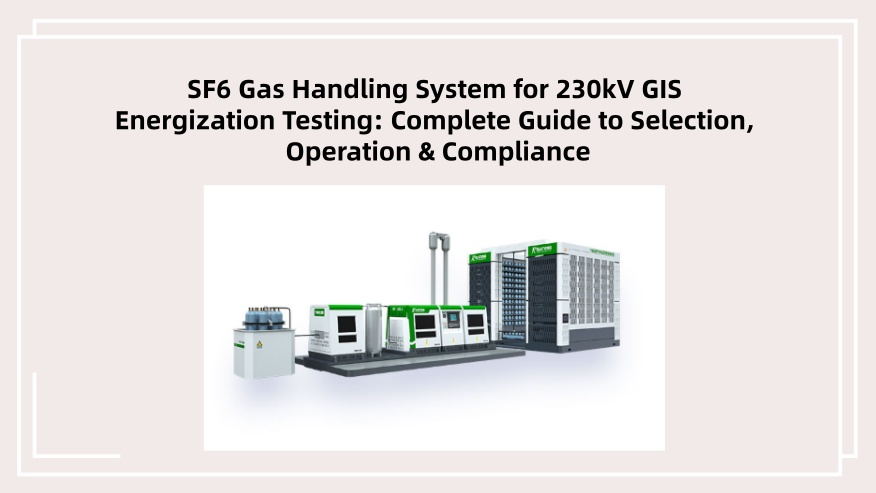
- SF6 Relations
- 2025-09-12
In the power industry, 230kV Gas-Insulated Switchgear (GIS) plays a critical role in transmitting high-voltage electricity safely. Energization testing is a mandatory step before GIS commissioning, as it verifies the equipment’s insulation performance and operational reliability. At the heart of this testing process lies the SF6 gas handling system for 230kV GIS energization testing—a specialized solution that ensures sulfur hexafluoride (SF6) gas, the primary insulating medium in GIS, meets strict quality standards for accurate testing and long-term equipment safety.
Why SF6 Gas Handling Systems Matter for 230kV GIS Energization Testing
SF6 gas is ideal for GIS due to its excellent insulation and arc-quenching properties. However, its performance depends heavily on purity, moisture content, and pressure stability. During 230kV GIS energization testing, even minor impurities (e.g., air, moisture, or decomposition byproducts) can skew test results, leading to false failures or, worse, undetected defects that cause equipment breakdowns post-commissioning.
A dedicated SF6 gas handling system for 230kV GIS energization testing addresses these risks by controlling the entire gas lifecycle during testing: from gas recovery and purification to drying, storage, and precise refilling. Without this system, manual gas handling would be inefficient, error-prone, and likely to introduce contaminants—undermining the validity of energization tests and threatening grid safety.
Core Functions of an SF6 Gas Handling System for 230kV GIS Testing
To support reliable 230kV GIS energization testing, the system must deliver four key functions:
1. SF6 Gas Recovery
Before testing, the system extracts residual SF6 from the 230kV GIS chamber to avoid mixing with new gas. High-efficiency recovery pumps (with rates of 5–10 m³/h for 230kV systems) ensure up to 99% of gas is recovered, reducing waste and environmental impact (SF6 is a potent greenhouse gas, so minimizing emissions is critical).
2. Purification and Drying
Impurities like moisture and air are the biggest threats to test accuracy. The system uses multi-stage filters (molecular sieves, activated carbon) to remove moisture to ≤50 ppm (by volume) and air to ≤0.5%—levels mandated by IEC 60480 (the global standard for SF6 handling). This ensures the gas meets the insulation requirements for 230kV energization tests, such as partial discharge and dielectric strength measurements.
3. Precise Gas Refilling
During testing, the system injects purified SF6 into the GIS chamber at a controlled pressure (typically 0.4–0.6 MPa for 230kV GIS) and flow rate. Digital pressure regulators and flow meters prevent over-pressurization or uneven gas distribution, which could damage GIS components or distort test data.
4. Real-Time Monitoring
Integrated sensors track gas purity, moisture content, and pressure throughout the process. Data is displayed on a user-friendly interface, allowing technicians to adjust parameters in real time—ensuring consistency with 230kV GIS energization testing protocols.
How to Select the Right SF6 Gas Handling System for 230kV GIS Testing
Not all SF6 handling systems are suitable for 230kV GIS energization testing. When choosing a system, prioritize these factors:
- Capacity Matching: Select a system with a gas recovery/purification capacity aligned with the 230kV GIS volume (e.g., 10–20 m³ for medium-sized 230kV GIS units). Undersized systems will prolong testing time, while oversized ones increase costs.
- Portability: Most 230kV GIS energization tests occur on-site. A compact, wheeled, or trailer-mounted system improves maneuverability in tight substation spaces.
- Compliance: Ensure the system meets international standards (IEC 60480, IEEE C37.122) and local environmental regulations (e.g., EPA limits on SF6 emissions).
- Automation: Automated functions (auto-shutoff when purity thresholds are met, remote monitoring) reduce human error and streamline testing—critical for large-scale 230kV projects.
Best Practices for Operating the System During Testing
To maximize the system’s effectiveness and ensure test accuracy:
- Pre-Test Inspection: Check filters, hoses, and seals for wear. Leaks can introduce air into the GIS chamber, invalidating test results.
- GIS Chamber Preparation: Evacuate the GIS chamber to a vacuum level of ≤1 mbar before refilling with purified SF6—this removes residual moisture and air.
- Post-Test Gas Management: After testing, recover SF6 from the GIS chamber and store it in sealed cylinders. Do not vent SF6 to the atmosphere; use the system’s purification function to reuse gas for future tests.
- Regular Maintenance: Replace filters every 50–100 operating hours and calibrate sensors annually to maintain performance.
The SF6 gas handling system for 230kV GIS energization testing is not just a supporting tool—it is the foundation of reliable, safe, and compliant testing. By ensuring SF6 gas meets strict purity and moisture standards, the system prevents costly test failures, protects 230kV GIS equipment from damage, and reduces environmental impact. For power utilities and substation operators, investing in a high-quality, standards-compliant SF6 gas handling system is essential to safeguarding grid stability and ensuring successful 230kV GIS commissioning.
Leave a Reply